The US military operates globally, and one of the key enablers of this is Military Sealift Command (MSC). MSC is an auxiliary of the US Navy that operates civilian-manned auxiliaries of various types in support of USN and DoD missions. This includes everything from point-to-point transports and survey ships to the Navy's fleet of underway replenishment vessels, which I discussed last time.
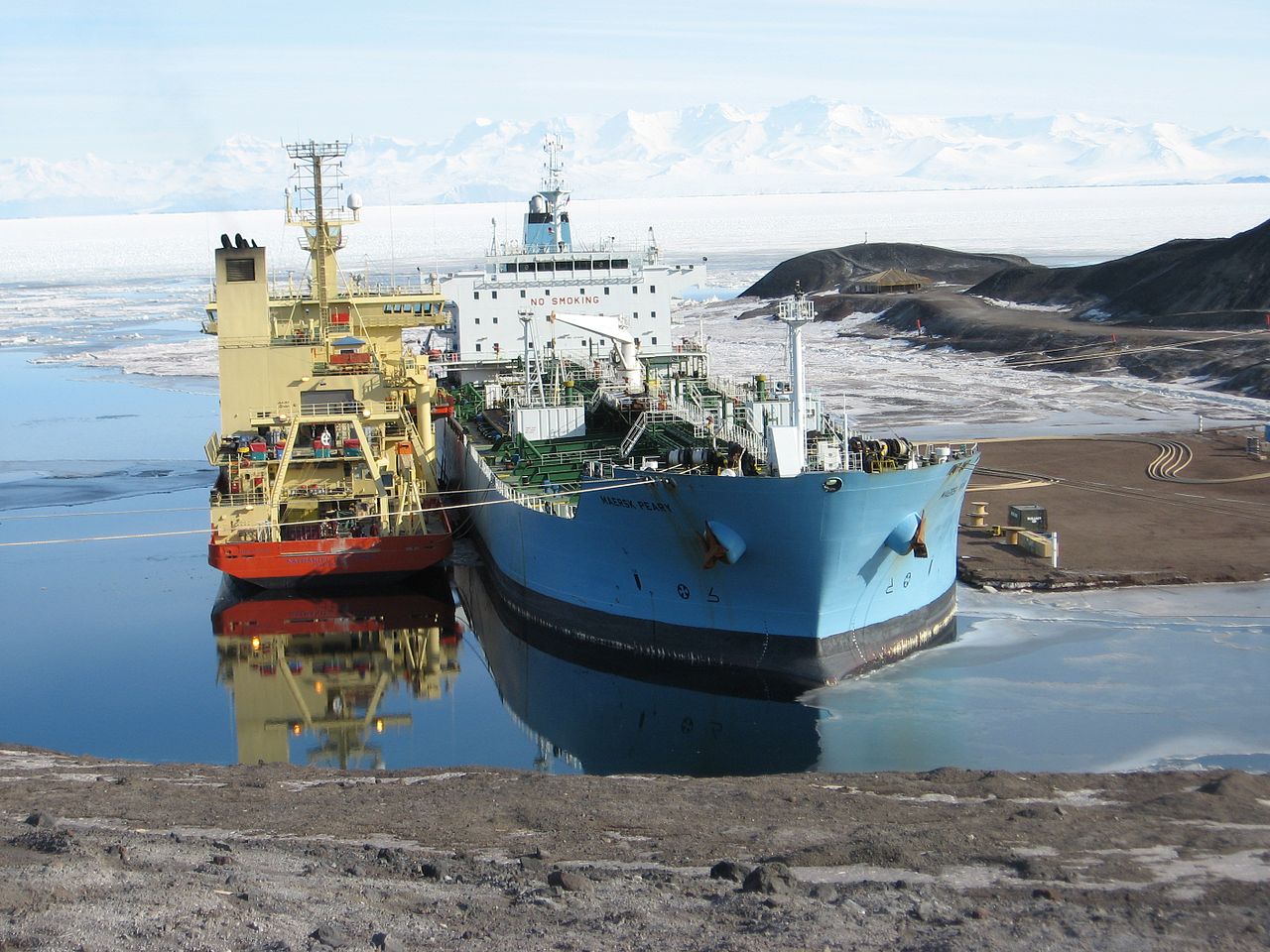
MV Maersk Peary delivers fuel to McMurdo in Antarctica
But while the UNREP ships may be the most photogenic of MSC's fleet, its responsibilities go much further than that. Despite America's extensive airlift force, over 90% of the DoD's equipment goes by sea, courtesy of MSC. Legally, they are required to prioritize the use of privately-owned American-flagged vessels, and ships on long-term charters are used extensively to provide dry cargo and petroleum products to DoD facilities around the world. The majority of this fleet is relatively conventional product tankers, with a few dry cargo ships to support isolated outposts like Thule in Greenland and McMurdo in Antarctica.1 Shorter-term charters are also used to plug holes, but the decrepit state of the American merchant marine means that government-owned vessels are the bulk of the sealift force, although most are operated by companies under contract.
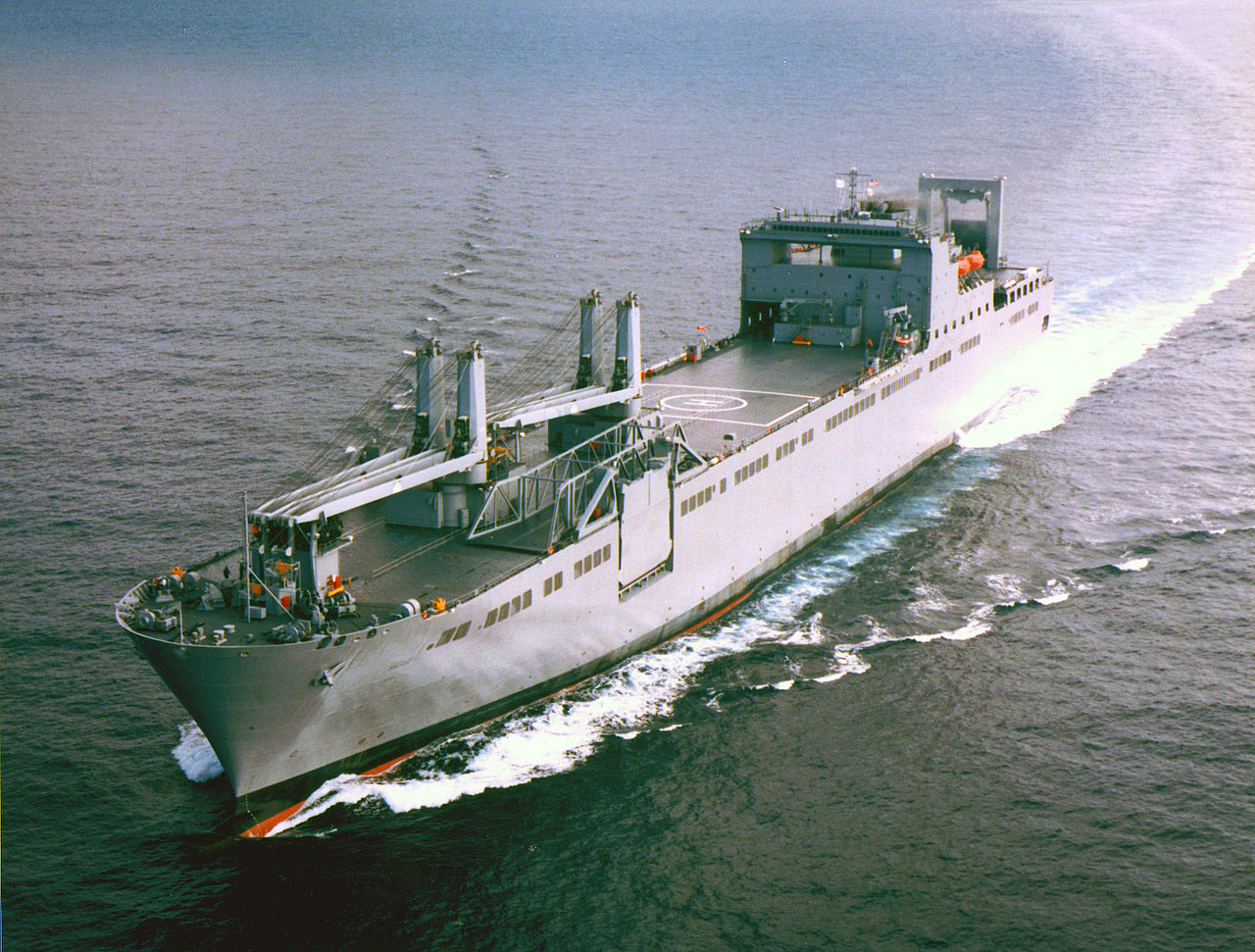
USNS Bob Hope, an LMSR
The core of the sealift force is the Large Medium-Speed Ro-Ro (LMSR) ships. Each one is capable of carrying 300,000 square feet or more of vehicles and containers, enough for an entire armored brigade, at 24 kts, then unloading them over ramps in the stern or sides. Traditionally, this would be done at a pier, but the ships also have the capability to do so into lighters or landing craft at sea, in case local ports are damaged. They are backed up by other government-owned vessels, capable of carrying a broader variety of cargo, including not only vehicles and containers, but also various types of fuel, palletized cargo and even water for a field force unable to secure local supplies. Normally, these ships are kept in US ports with only partial crews onboard, but are required to be able to be fully activated within 5 days. MSC regularly tests this capability through no-notice drills, known for some reason as Turbo Activations.
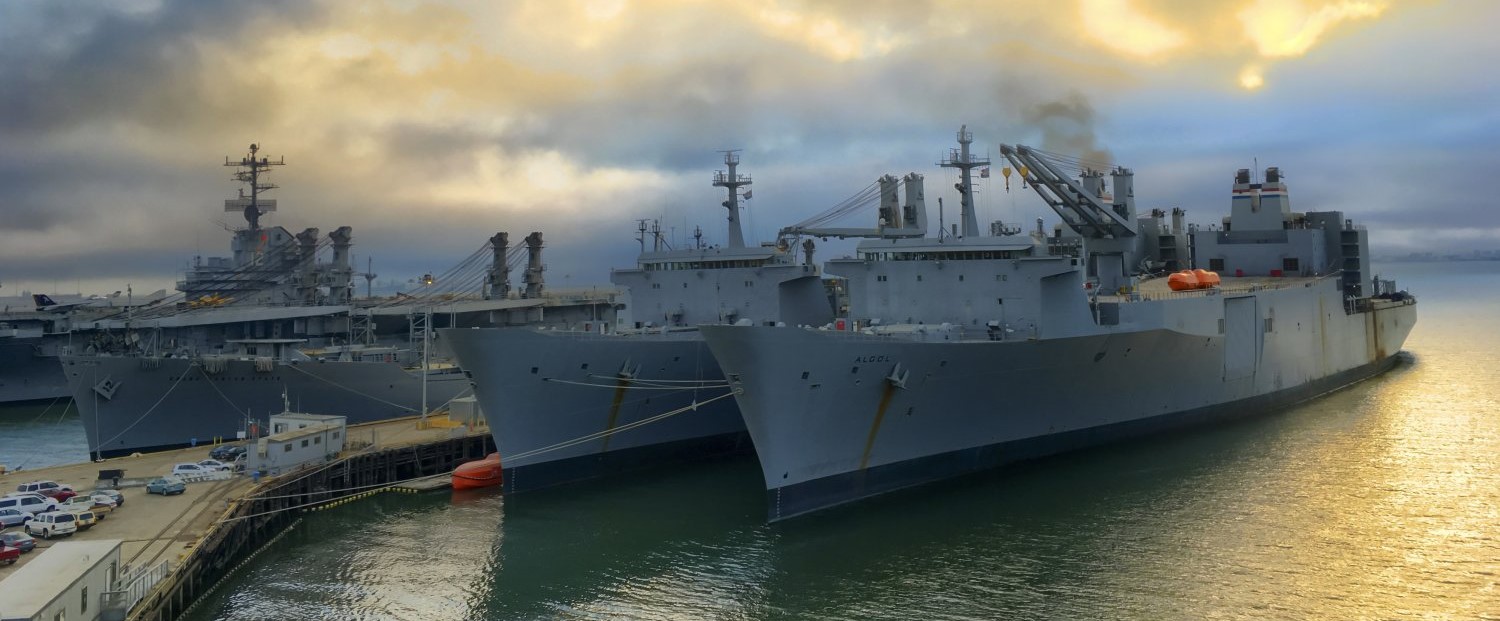
Fast Ro-Ros Algol and Capella with crane ship Grand Canyon State and museum carrier Hornet
If even more capacity is needed, MSC can draw from the National Defense Reserve Fleet Ready Reserve Force, a collection of older cargo ships maintained by the Maritime Administration (MARAD), mostly kept in somewhat lower readiness than the MSC-controlled ships. The vast majority of these are relatively slow (20 kt) Ro-Ros, but a few ships stand out. The crown jewel of the RRF's Ro-Ros is the Algol class, built for a 33-kt container service in the early 70s and snapped up by the US government when that proved too expensive to turn a profit. The 8 ships of this type transported 13% of all cargo between the US and Saudi Arabia during the first Gulf War, and are maintained on 96-hour alert today. Other oddities in the RRF are six crane ships, designed to replace shore-based cranes in forward areas, and the aviation ships Curtis and Wright, each loaded with the equipment for a Marine aviation maintenance unit.
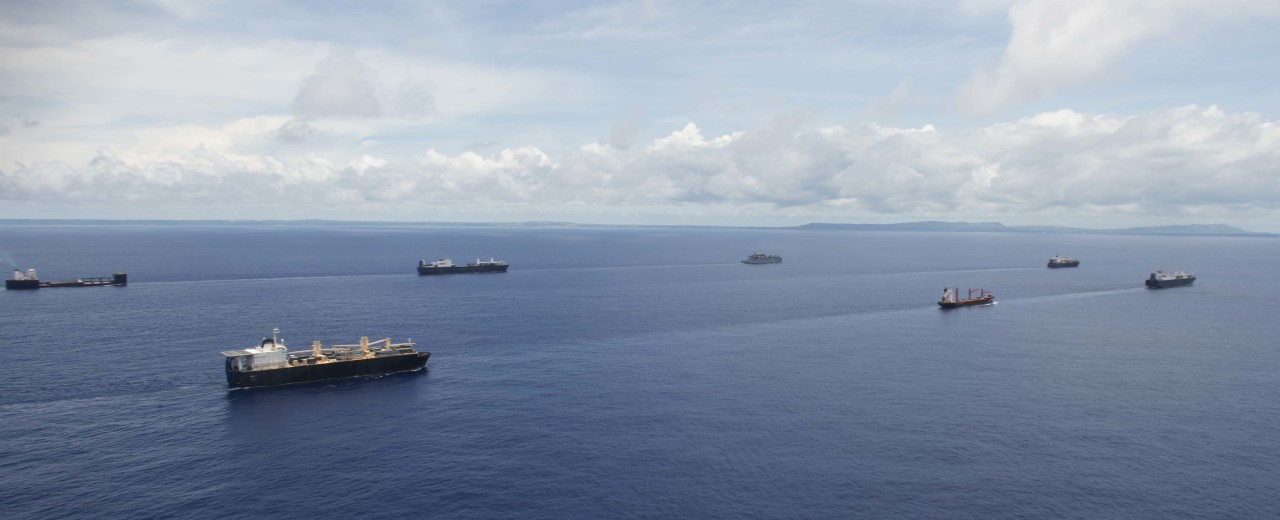
Ships of MPSRON 3 at sea
Curtis and Wright are hardly the only ships pre-loaded with equipment in case a crisis breaks out, although most of the pre-positioning ships are controlled directly by MSC and located overseas. The idea is to reduce the time required for the US to deploy a substantial force by stationing ships loaded with equipment and supplies in a forward location. When the unit is needed, the ships will steam to the area, unloading at a pier or using lighters, while the personnel to operate it will be flown in. The core of the prepositioning program is Maritime Prepositioning Squadrons 2 and 3, located at Diego Garcia and Guam respectively.2 Each has the equipment for a Marine Expeditionary Brigade, which includes not only ground troops but also aircraft and logistics support, and sufficient supplies for 30 days of combat, loaded on half a dozen Ro-ro ships. To reduce dependence on port facilities, each squadron has recently been joined by an expeditionary transfer dock that should allow them to transfer cargo and vehicles from the transports to LCACs on the high seas. But while this is fine for solid cargo, it leaves something to be desired for petroleum products, and each squadron has one Offshore Petroleum Distribution System ship, equipped with hoses that allow it to take fuel from tankers up to 8 miles offshore and pump it over the beach.
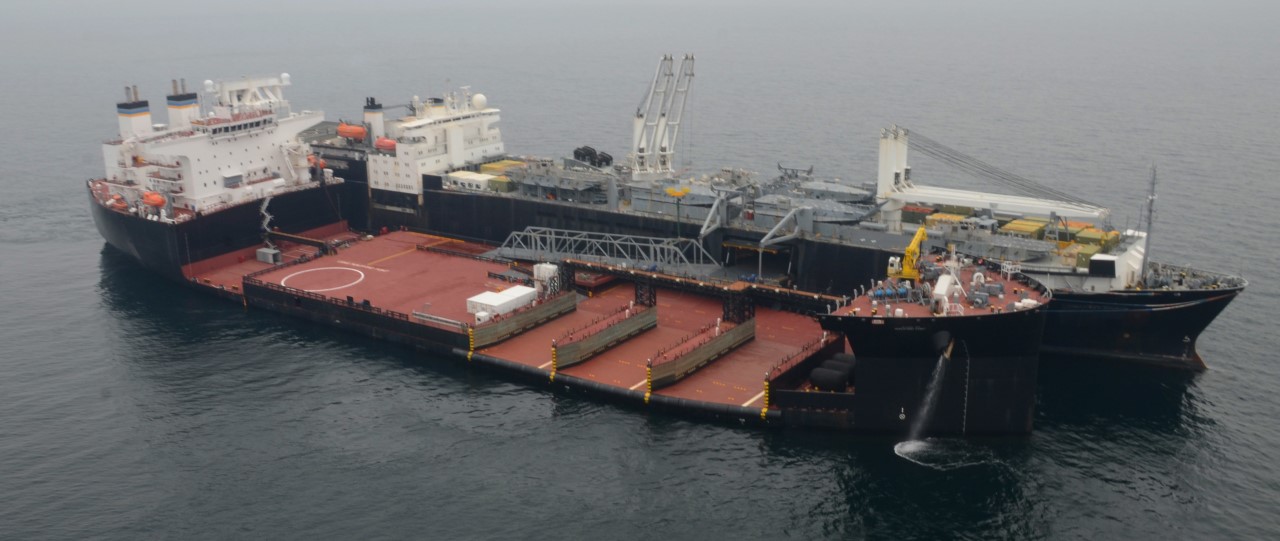
Expeditionary Transfer Dock Montford Point and LMSR Stockham
In action, the MPS concept has proven successful, with the ships of MPSRon-2 providing the first heavy units in Saudi Arabia in 1990, and other vessels from the force deploying to a number of crises since then. Of course, the Marine Corps isn't the only service with an interest in prepositioning; both the Army and Air Force have ships at Guam and Diego Garcia. Five of the Army's LMSRs are pre-loaded and forward-based, along with a pair of container ships to carry their ammo. The Air Force has only two ships, and their cargo is mostly containers of spare parts, supplies, and ordnance.
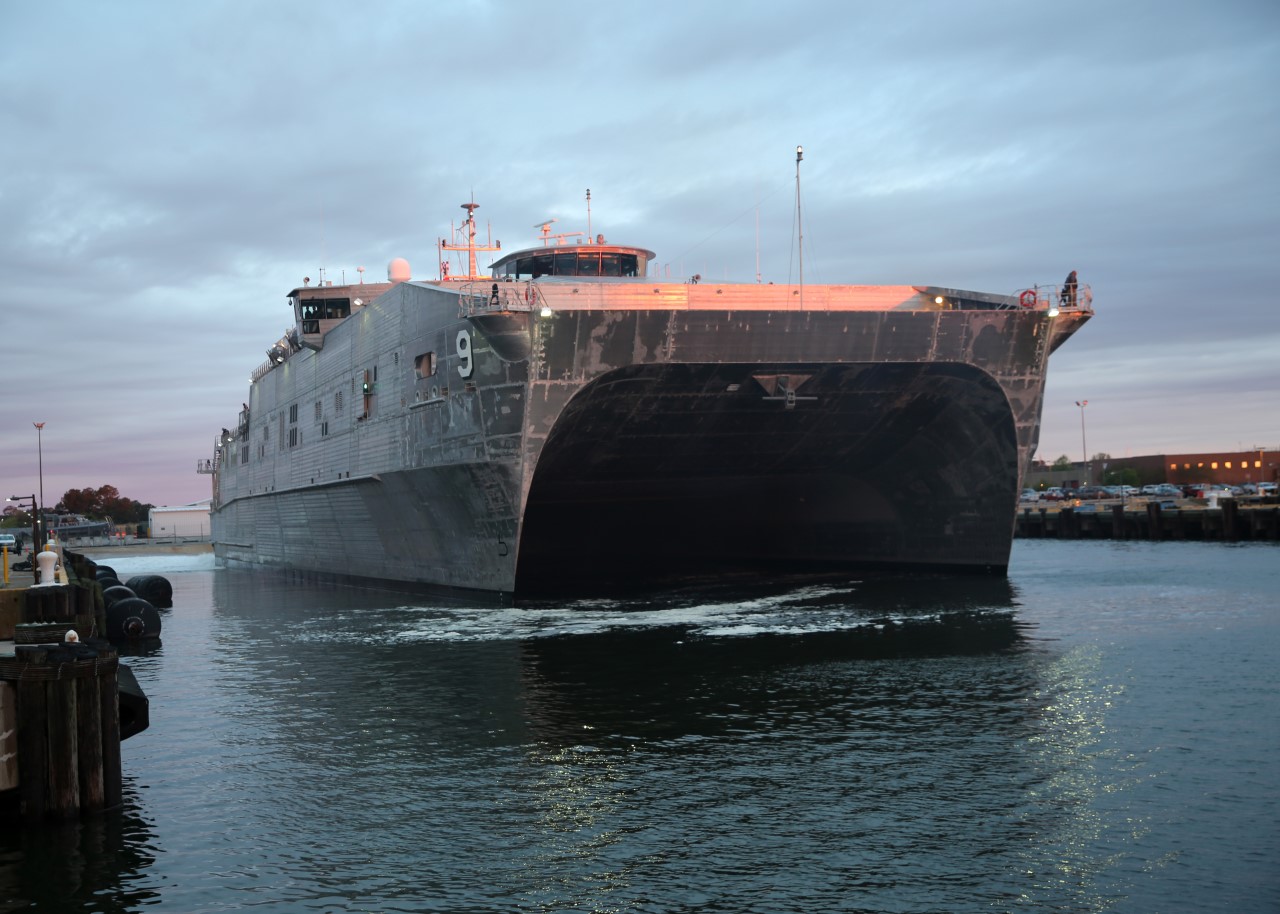
USNS City of Bismarck, a missed opportunity
On the opposite end of the spectrum from the prepositioning ships are the Expeditionary Fast Transports (EPFs), formerly known as Joint High Speed Vessels (JHSVs). These are catamaran vessels capable of carrying 300 passengers and 600 tons of cargo at up to 35 kts. Unfortunately, this comes at a serious cost in range and seakeeping, and the ships are also unable to unload except at a pier. The 16-ship buy is coming to an end, although the Alabama congressional delegation has insisted on a couple more fitted as hospital ships.
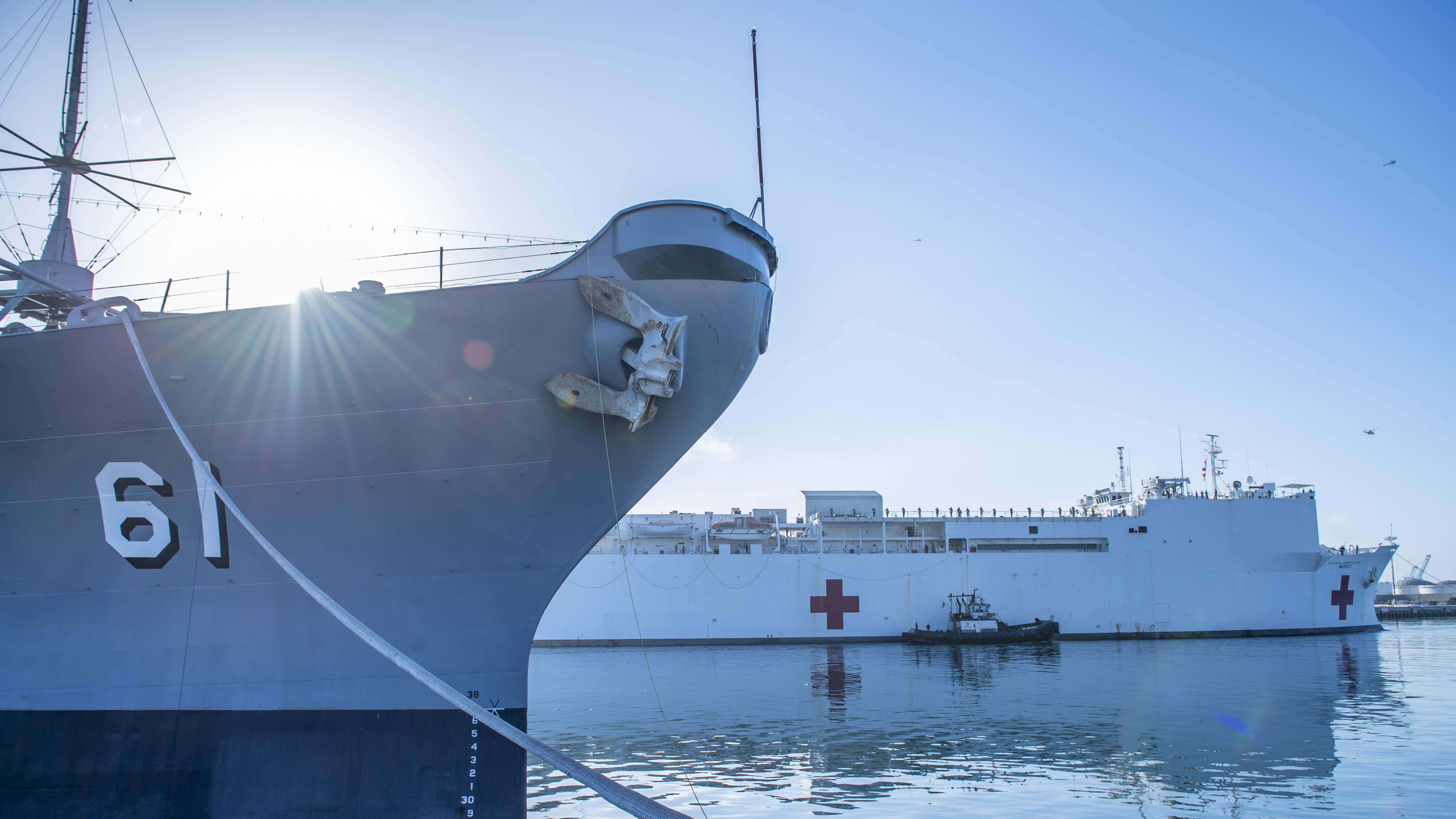
USS Mercy passing Iowa in 2020
But not all of MSC's ships are tasked with moving stuff about. MSC manages hospital ships Comfort and Mercy, although their medical staffs are USN personnel, mostly reservists who do the same jobs aboard ship that they do in daily life. Each ship was converted from an oil tanker in the 80s, and has 1000 beds, 12 operating facilities, full dental and optometry facilities, CT scanners and the ability to do any medical procedure short of organ transplants. These are getting rather old, and look to be at least partially replaced by the medical version of the EPFs.
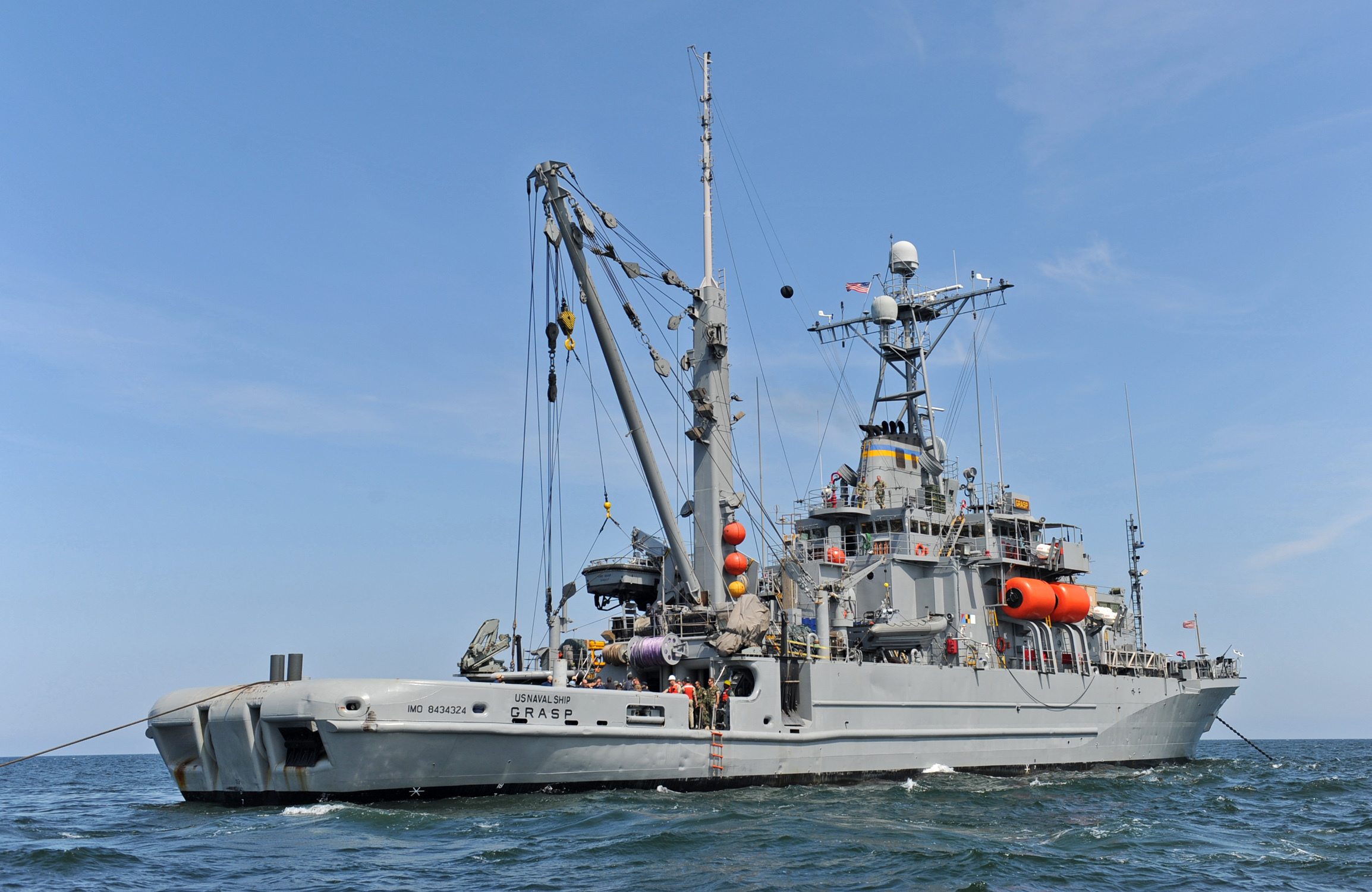
Salvage ship Grasp
Much as the hospital ships deal with sick people, the tugs and salvage vessels deal with sick ships. Two salvage vessels, Grasp and Salvor, have comprehensive suites of diving equipment, heavy booms, rollers at bow and stern for lifting up to 300 tons, and firefighting monitors capable of putting out 1,000 gallons of foam or water per minute. The three Navy-owned tugs of the Powhatan class left in service can exert 54 tons of force when towing, and put out over twice as much firefighting foam as the salvage ships if called upon to do so.
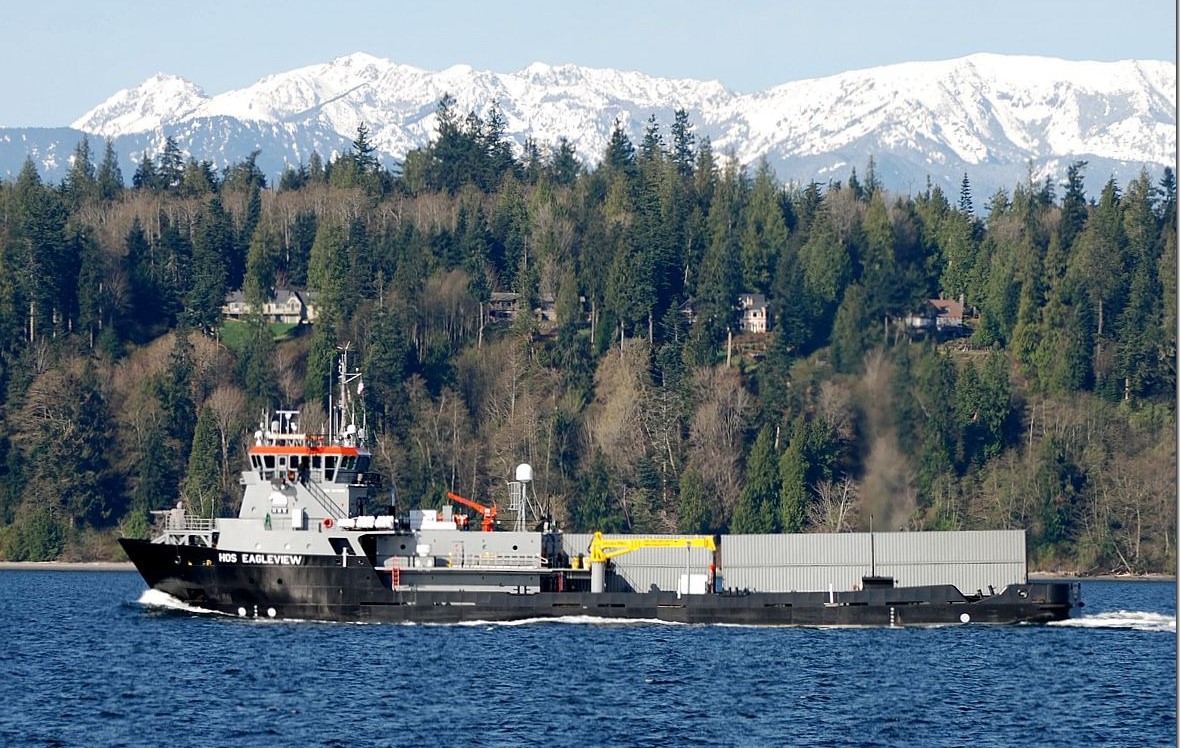
Eagleview, one of the submarine escorts
And then we come to what is known as Special Missions. The largest category are classified as Submarine and Special Warfare Support, which is about as unhelpful a title as it is possible to get. In practice, some of these ships are tasked with escorting SSBNs in and out of their bases (the only armed vessels MSC operates), while others operate submarine rescue equipment or provide bases for special forces to work from. Also tasked with working undersea is cable repair ship Zeus, responsible for maintaining the bottom-mounted sonar arrays the US has deployed around the world, with specialized equipment for handling the arrays at bow and stern.
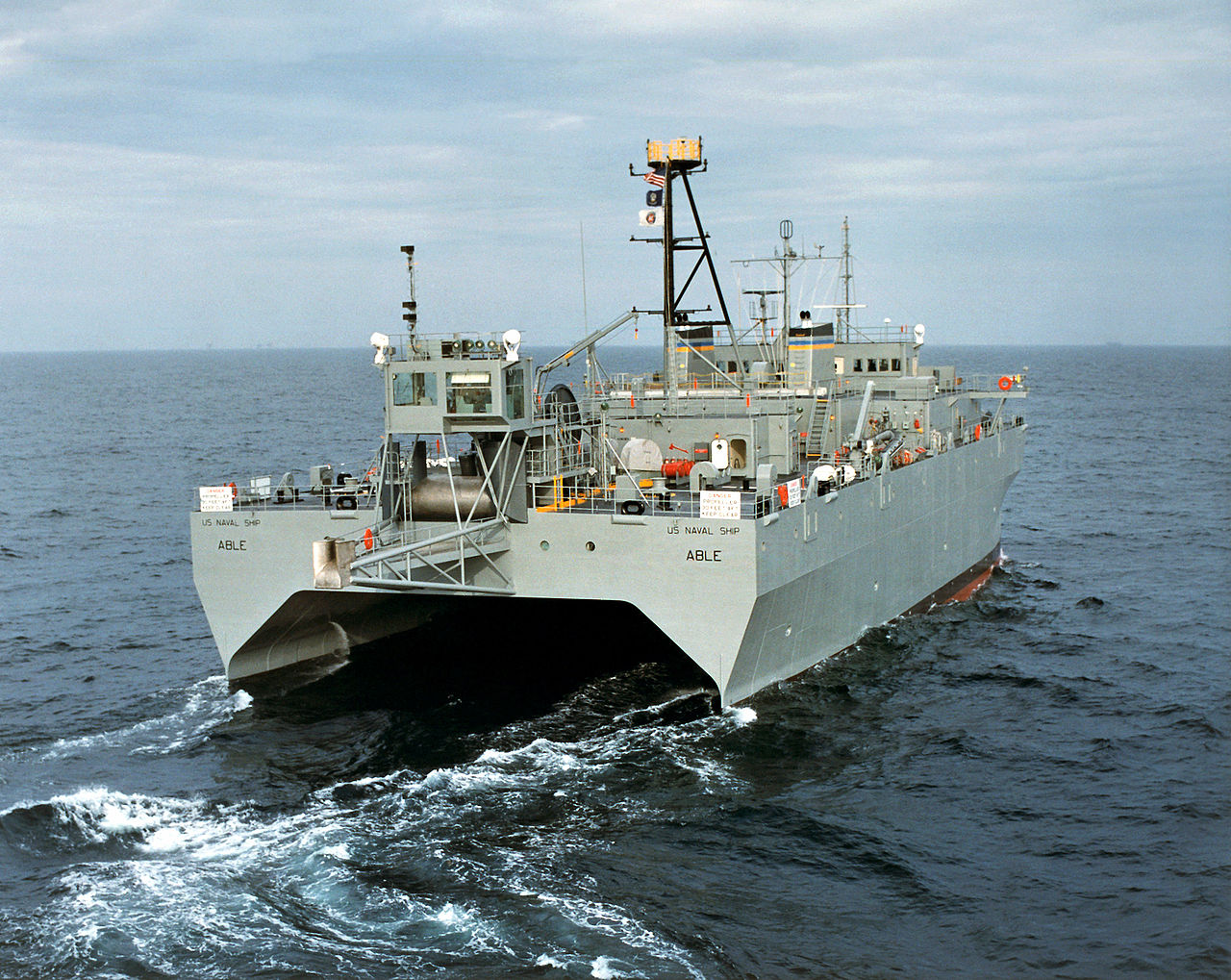
USNS Able showing her SURTASS equipment
The others in the Special Missions category are tasked with gathering information of some type. Five Ocean Surveillance Ships use extremely sophisticated towed arrays to monitor submarines, their SWATH design giving them exceptional stability in rough seas. Two tracking ships have sophisticated radar to monitor missile tests, either American or enemy. And for monitoring operational missiles, there's the Sea-Based X-Band Radar (SBX), a giant radar mounted on a semi-submersible platform of the kind usually used for oil drilling. SBX is normally based in Alaska or Hawaii, and provides a key link in America's missile defenses. Lastly, there are the five ships of the Pathfinder class, tasked with surveying the oceans for information ranging from simple depth to the complexities of underwater physics and acoustics.
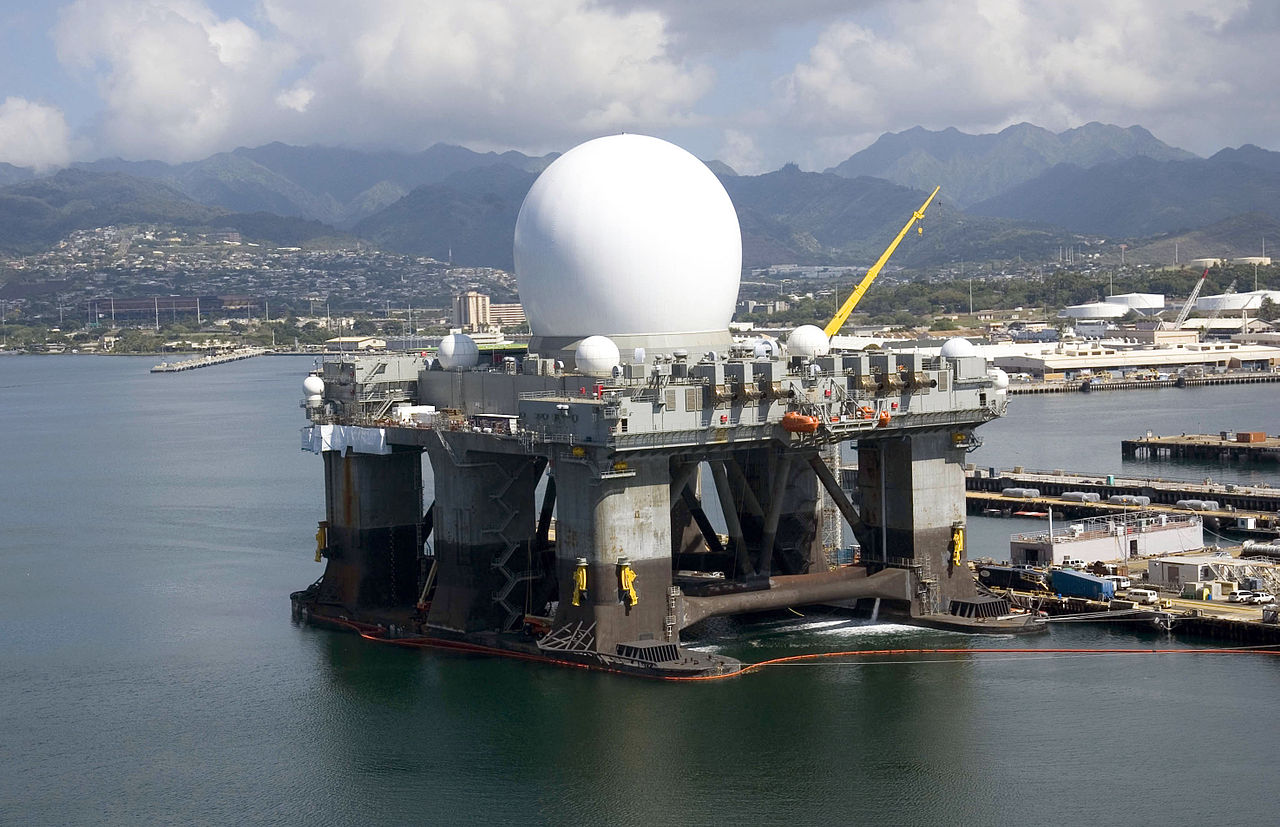
SBX at Pearl harbor
Without the work of the civilian mariners of MSC, America's fighting force would be unable to do their jobs. From charting harbors to delivering equipment, weapons and supplies to forces ashore and afloat, their efforts are vital to the nation's defense, and ultimately, the security of the free world.
1 I suspect that a lot of the cargo to less remote bases goes via the commerical container shipping system, but don't feel like plumbing the depths of the DoD logistics system to confirm this. ⇑
2 MPSRon1 was in the Mediterranean, but it didn't have a permanent base and was disbanded in 2012. ⇑

Comments
Outstanding work on this Bean. Really first rate.
Thank you for covering this as it is something that I and a number of friends/colleagues have been quite curious about. It is a topic that is very much underappreciated to be sure.
Is there a particular reason the Large, Medium-Speed Ro-Ros are abbreviated here as LSMR rather than LMSR? Every other reference I could find in a quick (~15m) Google search has them as "LMSR," and the only naval-related reference I found to "LSMR" was rocket-armed landing ships in WW2 (and technically "LSM(R)").
@Neal
Thanks. Your question about that is what led to this series, so I'm glad you liked it.
@Philistine
Yes, there is. It's a typo.
Probably also in the Special Missions category would be the MV Ocean Trader, which I've read is sort of a FOB at sea for SF crews, aircraft and boats. Any info beyond Wiki about that?
She is, and I did mention her type. The reason I didn’t go into more detail is because I couldn’t find any, and because Special Warfare is something I don’t spend much time on.
Bean - I'm the retired Army guy in Neal's discussion group where the MSC questions arose (USA, USAF, and two civilians). Clearly we were out of our depth. Truly enjoyed reading the piece and understanding the structure and ownership a bit better. (FWIW I worked briefly on the Prepo Afloat concept in '93 as prepositioned stocks were being drawn down in Europe.) Again - thanks for the informed view!
I was surprised they turned the SBX over to the MSC. I wonder what's been going on with that program...
@Fitz
Glad I could help. It is kind of a tangle.
@echo
Remember that just because the ship is run by MSC doesn't mean that there aren't Navy personnel to operate the mission systems. MSC is just responsible for the ship (or drilling platform part.)
@bean: Didn't think it was MSC but MDA that echo was referring to.
Ah, Hospital Ships. The worst ship I've ever deployed on.
Is anyone able to describe how the Aviation Logistics Ships work in a bit more detail? I've never understood why they need special geometry. It was also surprising to me that ships specializing in aviation logistics wouldn't have a hangar.
Will you be doing a part 3 covering the hybrid-crewed ships?
Apparently, the reason the AVBs are specialized is that they're set up so the maintenance unit can work onboard ship instead of having to disembark and set up ashore. That's unusual in the prepositioning force, most of which are essentially just cargo ships.
And I'm not going to cover the hybrid-crew ships at the moment. Maybe down the road.
How do they get the helicopters inside to work on them? Roll them in and out on the stern ramp? Doesn't look like there is access to the interior spaces from the flight deck.
I don't think they do. They're set up for intermediate maintenance, not first-line. In normal terms, they're the people who fix stuff that the squadron personnel can't, and on a practical level, that usually means the broken part is taken off the plane and swapped out for another one. So you're looking at things like engine overhauls and fixing avionics boxes instead of just grabbing another one off the shelf.
From what I can see from some short videos it looks like they don't service the helicopters on the ship; the ship is just a transport for the maintenance group, which is deployed on land to actually service aircraft. It seems like the have a limited ability to service them onboard, but only on the flight deck. (I think that's more of a statement of having the parts and personnel onboard, since you can have a limited ability to service helicopters anywhere, as long as they are on the ground.)
If that's the case I don't understand why you need a special type of ship. Maybe it's just that they need a vessel that can do both RORO and load/unload bulky things via onboard cranes, and it's probably unusual to have both in one vessel.
I don't think that's quite it. Note that a normal prepositioning ship would not be able to work with the equipment aboard ship at all. It would be packed away in trucks and containers, and you couldn't get to it until it was unloaded. They had to do some work to get a reasonable capability while the equipment was onboard.
The Navy Fact File for the T-AVBs says:
I'd be interested to understand how they get the helicopters in and out of the RORO deck while anchored offshore. I guess they could use the cranes to transfer them between the flight deck and the RORO deck, but that seems risky and error-prone.
This article has more details. It doesn't spell it out in detail, but it sounds like they don't work on entire helicopters onboard the ship - just removable components from helicopters. Once the maintenance team and their equipment is disembarked they, they can work on complete helicopters on land.
I could be completely misunderstanding though.
Some one needs to do some heavy thinking about hiring plenty more personnel. I have been on my present ship since May. The ship has been short about 3-4 ABM's and ate least 2 watch standers, not to mention several crew members being at least one month overdue for reliefs. WTF over.